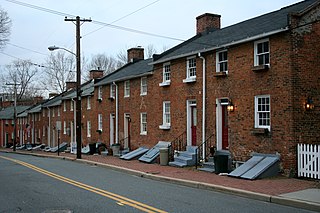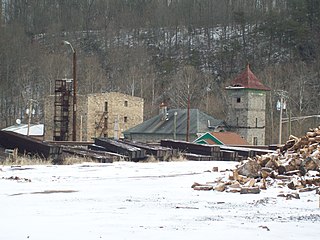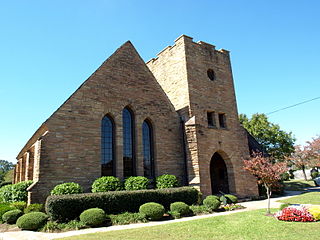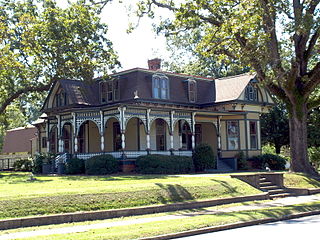
Gadsden is a city in and the county seat of Etowah County in the U.S. state of Alabama. It is located on the Coosa River about 56 miles (90 km) northeast of Birmingham and 90 miles (140 km) southwest of Chattanooga, Tennessee. It is the primary city of the Gadsden Metropolitan Statistical Area, which has a population of 103,931. As of the 2020 census, the population of the city was 33,945. In the 19th century, Gadsden was Alabama's second-most important center of commerce and industry, trailing only the seaport of Mobile. The two cities were important shipping centers: Gadsden for riverboats and Mobile for international trade.

Savage is an unincorporated community and census-designated place located in Howard County, Maryland, United States, approximately 18 miles (29 km) south of Baltimore and 21 miles (34 km) north of Washington, D.C. It is situated close to the city of Laurel and to the planned community of Columbia. As of the 2020 census, it had a population of 7,542. The former mill town is a registered historic place, and has several original buildings preserved within and around the Savage Mill Historic District.

Oella is a mill town on the Patapsco River in western Baltimore County, Maryland, United States, located between Catonsville and Ellicott City. It is a 19th-century village of millworkers' homes.

The Savage Mill is a historic cotton mill complex in Savage, Maryland, which has been turned into a complex of shops and restaurants. It was placed on the National Register of Historic Places in 1974. It is located in the Savage Mill Historic District. Buildings in the complex date from 1822 to 1916.

Dallas Mill was a manufacturer of cotton sheeting in Huntsville, Alabama, United States. The first of four major textile mills in Huntsville, the mill operated from 1891 until 1949, before it was converted for use as a warehouse in 1955 and burned in 1991. The village, constructed to house workers and their families, was incorporated into the city in 1955. The mill and its mill village are listed on the National Register of Historic Places.

This list is of the properties and historic districts which are designated on the National Register of Historic Places or that were formerly so designated, in Hennepin County, Minnesota; there are 190 entries as of April 2023. A significant number of these properties are a result of the establishment of Fort Snelling, the development of water power at Saint Anthony Falls, and the thriving city of Minneapolis that developed around the falls. Many historic sites outside the Minneapolis city limits are associated with pioneers who established missions, farms, and schools in areas that are now suburbs in that metropolitan area.
Harriet Francoeur Nevins was an American philanthropist and animal welfare advocate born in Roxbury, Massachusetts. Widow of David Nevins Jr., she used her inheritance to leave a legacy to the people of the Bay State. She died November 14, 1929 at her home in Methuen, Massachusetts.

Daniels Mill is a historic mill complex located at Daniels, Howard County, Maryland, in a sheltered, wooded valley of the upper Patapsco River. The complex consists of seven early industrial structures, several concrete block and brick structures of 20th century date, and Gary Memorial United Methodist Church, a granite church built in the High Victorian Gothic style with an off-center tower entrance on the west gable. South of the church is a small cemetery.

The Savage Mill Historic District is a national historic district located at Savage, Howard County, Maryland. The district comprises the industrial complex of Savage Mill and the village of workers' housing to the north of the complex.

The George P. MacNichol House, also known as the Ford-MacNichol House, is a house located at 2610 Biddle Avenue in Wyandotte, Michigan. It was designated a Michigan State Historic Site in 1973 and listed on the National Register of Historic Places in 1984.

Riverdale is a historic plantation house near Selma, Dallas County, Alabama. Architectural historians consider it to be the "most elegant and refined house of its period in Dallas County." The two-story wood-frame house was built in the Federal-style in 1829. It is five bays wide, with a two-tiered, pedimented portico spanning the central bay. It was built by Virgil H. Gardner, a native of Jones County, Georgia, for his bride, Margaret Loise Aylett of Virginia. Their daughter, Mary Gardner, was married in the house in 1854 to Henry Quitman, son of former Mississippi governor John A. Quitman.

The Albertville Depot, also known as L&N Railroad Depot, is a historic train depot in Albertville, Alabama. It was built by the Nashville, Chattanooga and St. Louis Railway in 1892, one year after the town was incorporated. The building measures 112 by 40 feet, and is divided into three rooms: two offices and one larger warehouse space.

The Nichols Memorial Library is a historic library building on Main Street in Kingston, New Hampshire, United States. Built in 1898, it is distinctive statewide as the only local library building exhibiting Shingle style and Richardsonian Romanesque features. It was used as the town library until 2012, and now houses the town's research collection and archives. The building was listed on the National Register of Historic Places in 1981.
Bemis is a former company town in Madison County, Tennessee, United States, now part of the city of Jackson. The Bemis Brothers Bag Company established the town in 1900 to be the site of a cotton mill and housing for the mill workers. A 450-acre (180 ha) area of Bemis was added to the National Register of Historic Places in 1991 as the Bemis Historic District. Much of the area is also a local historic district.

The Alabama City Wall Street Historic District is a historic district in Gadsden, Alabama. Wall Street was the main commercial street in the town of Alabama City. The city was founded in 1891 halfway between Gadsden and Attalla, with intentions of becoming the major industrial hub of Northeast Alabama. In 1895 the town landed its first major concern, a cotton mill built by the Dwight Manufacturing Company of Chicopee, Massachusetts. Its second major factory, the Alabama Steel and Wire Company, was opened in 1902. By 1915, a thriving commercial district had grown up around 7th Avenue, which became known as "Little Wall Street". A fire in 1927 damaged or destroyed many structures along Wall Street and Meighan Avenue. The city would never recover from the loss, especially as neighboring Gadsden flourished; Alabama City voted to merge into Gadsden in 1932. The architecture of the district represent the changing commercial styles of the 1910s through the 1930s. Most are constructed in simple, brick styles with parapet roofs, some with more decorative brickwork. Art Deco-influenced features such as terra cotta coping and glass tile accents are present on later buildings. Other notable buildings are an Art Deco fire station and the Classical Revival library. The district was listed on the National Register of Historic Places in 2002.

The Forrest Cemetery Chapel and Comfort Station are historic structures in Gadsden, Alabama. The chapel, comfort station, and cemetery gates were built in 1935 by workers from the Works Progress Administration, and designed by local architect Paul W. Hofferbert, who also designed the Legion Park Bowl. The chapel is designed in Gothic Revival style, with a steeply pitched gable with three lancet arched windows and a square tower with lancet arch opening for the entrance. The front gate columns and wall are connected to a hipped roof comfort building, which originally housed restrooms, but is now used for storage. All three are constructed of rough-cut sandstone blocks quarried from nearby Lookout Mountain. The buildings were listed on the Alabama Register of Landmarks and Heritage in 1988 and the National Register of Historic Places in 1992.

The Gadsden Times-News Building is a historic building in Gadsden, Alabama. It was built by the owners of The Gadsden Times-News in 1904. After changing their name to The Gadsden Times in 1924, the paper moved its operation to another building in 1927. It has since housed a variety of commercial businesses. The two-story building is brick and rounded on the street corner. The 4th Street ground-level façade has cast iron pilasters and entablature, with large windows surrounded by smaller panes. The second floor has a series of arched one-over-one sash windows and a cornice with heavy modillions, which is raised on the curve. The building was listed on the Alabama Register of Landmarks and Heritage in 1982 and the National Register of Historic Places in 1983.

The Charles Gunn House is a historic residence in Gadsden, Alabama. The house was built in 1886 by Edward Tracy Hollingsworth, a local merchant and banker. Charles Logan Gunn, a dentist, purchased the house in 1901. His daughter, Carolyn Gunn Bellenger inherited the house, and willed it to the city upon her death in 1990. The city restored the house and now rents it for meetings and events.

Alabama City is a former city and now a neighborhood within the city of Gadsden in Etowah County, Alabama, United States. It was equidistant between Gadsden and Attalla, Alabama, approximately 2 1/2 miles west of downtown Gadsden.





















